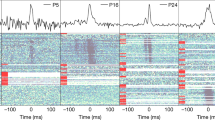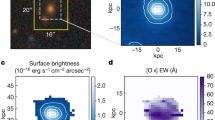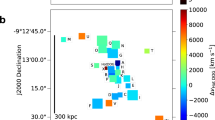Abstract
STARBURST galaxies have higher star formation and supernova rates than normal galaxies, triggered in many cases by the interaction of two galaxies1. Direct estimates of the supernova rate in starburst galaxies is difficult, because optical direction of super-novae is hampered by high background brightness and by dust2, both of which are associated with the starburst phenomenon. Radio observations do not suffer from these problems. We report here the discovery of two radio supernovae in the clumpy irregular galaxy Markarian 297 (Mkn 297, also known as NGC6052), which has been estimated3 to have a star formation rate ten times that of a normal spiral galaxy, and a supernova rate of 0.3–0.5 per year. It may consist of two interacting galaxies4. A variable radio source found in 1982 (ref. 5) was attributed to possible supernova activity, and our observations with the Very Large Array, combined with earlier published data, define a reasonable radio light curve for a supernova that exploded in July 1979. The variability resembles that of the young supernova SN1986J (ref. 6), but at maximum the supernova in Mkn 297 would have been about six times as bright. We also identify a second source in the galaxy as a supernova. The presence of two extraordinarily bright supernovae in the same region may be a particular result of the interaction between two galaxies.
This is a preview of subscription content, access via your institution
Access options
Subscribe to this journal
Receive 51 print issues and online access
$199.00 per year
only $3.90 per issue
Buy this article
- Purchase on Springer Link
- Instant access to full article PDF
Prices may be subject to local taxes which are calculated during checkout
Similar content being viewed by others
References
Keel, W. C. in Starbursts and Galaxy Evolution (eds Thuan, T., Montmerle, T. & Tran Thanh Van, J.) 307–312 (Editions Frontieres, Paris, 1987).
Chevalier, R. A. in Massive Stars in Starburst (eds Leitherer, C., Walborn, N., Heckman, T. & Norman, C. 169–181 (Cambridge University Press, 1990).
Klein, U., Heidmann, J., Wielebinski, R. & Wunderlich, E. Astr. Astrophys. 154, 373–375 (1986).
Alloin, D. & Duflot, R. Astr. Astrophys. 78, L5–8 (1979).
Heeschen, D. S., Heidmann, J. & Yin, Q. F. Astrophys. J. 267, L73–76 (1983).
Weiler, K. W., Panagia, N. & Sramek, R. A. Astrophys. J. 364, 611–625 (1990).
Condon, J. J., Helou, G., Sanders, D. B. & Soifer, B. T. Astrophys. J. Suppl. 73, 359–400 (1990).
Chevalier, R. A. Ann. N. Y. Acad. Sci. 422, 215–232 (1984).
Huchra, J. Astrophys. J. Suppl. 35, 171–195 (1977).
Kronberg, P. P., Biermann, P., Schwat, F. R. Astrophys. J. 291, 693–707 (1985).
Hummel, E., van der Hulst, M. J., Keel, W. C. & Kennicutt, R. C. Jr Astr. Astrophys. Suppl. 70, 517–530 (1987).
Author information
Authors and Affiliations
Rights and permissions
About this article
Cite this article
Yin, Q., Heeschen, D. Two radio supernovae in the unusual galaxy Markarian 297. Nature 354, 130–132 (1991). https://doi.org/10.1038/354130a0
Received:
Accepted:
Issue Date:
DOI: https://doi.org/10.1038/354130a0
This article is cited by
-
Radio emission in active galaxies: the starburst scenario
Astrophysics and Space Science (1993)
Comments
By submitting a comment you agree to abide by our Terms and Community Guidelines. If you find something abusive or that does not comply with our terms or guidelines please flag it as inappropriate.



